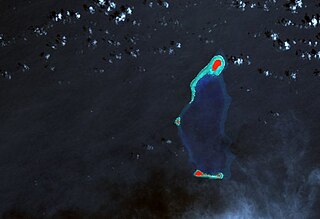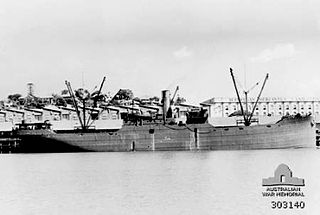
The Grumman HU-16 Albatross is a large, twin–radial engined amphibious seaplane that was used by the United States Air Force (USAF), the U.S. Navy (USN), the U.S. Coast Guard (USCG), and the Royal Canadian Air Force primarily as a search and rescue (SAR) aircraft. Originally designated as the SA-16 for the USAF and the JR2F-1 and UF-1 for the USN and USCG, it was redesignated as the HU-16 in 1962. A new build G-111T Albatross with modern avionics and engines was proposed in 2021 with production in Australia to commence in 2025.

USS Williamson (DD-244/AVP-15/AVD-2/APD-27) was a Clemson-class destroyer in the United States Navy during World War II. She was named for Commander William Price Williamson.

Operation Christmas Drop is a tradition that started in 1952 that serves as a training mission for the U.S. Air Force. It has since become the longest-running U.S. Department of Defense mission in full operation, and the longest-running humanitarian airlift in the world. Supported by the local communities of Guam, it is primarily conducted from Andersen Air Force Base and Yokota Air Base, and targets Micronesia.
The history of the United States Coast Guard goes back to the United States Revenue Cutter Service, which was founded on 4 August 1790 as part of the Department of the Treasury. The Revenue Cutter Service and the United States Life-Saving Service were merged to become the Coast Guard per 14 U.S.C. § 1 which states: "The Coast Guard as established January 28, 1915, shall be a military service and a branch of the armed forces of the United States at all times." In 1939 the United States Lighthouse Service was merged into the Coast Guard. The Coast Guard itself was moved to the Department of Transportation in 1967, and on 1 March 2003 it became part of the Department of Homeland Security. However, under 14 U.S.C. § 3 as amended by section 211 of the Coast Guard and Maritime Transportation Act of 2006, upon the declaration of war and when Congress so directs in the declaration, or when the President directs, the Coast Guard operates as a service in the Department of the Navy.

USS LST-821, renamed USS Harnett County (LST-821/AGP-281), is an LST-542-class tank landing ship built for the United States Navy during World War II. She was named for Harnett County, North Carolina and was the only U.S. Naval vessel to bear the name. She served the United States Navy in World War II and the Vietnam War. She was transferred to South Vietnam's Republic of Vietnam Navy, which named her RVNS My Tho (HQ-800).

USS Kretchmer (DE-329) was an Edsall-class destroyer escort built for the U.S. Navy during World War II. She served in the Atlantic Ocean and the Pacific Ocean and provided destroyer escort protection against submarine and air attack for Navy vessels and convoys.

USS Yakutat (AVP-32) was a United States Navy Barnegat-class small seaplane tender in commission from 1944 to 1946. Yakutat tended seaplanes in combat areas in the Pacific during the latter stages of World War II. After the war, she was in commission in the United States Coast Guard from 1948 to 1971 as the Coast Guard cutter USCGC Yakutat (WAVP-380), later WHEC-380, seeing service in the Vietnam War during her Coast Guard career. Transferred to South Vietnam in 1971, she was commissioned into the Republic of Vietnam Navy as the frigate RVNS Trần Nhật Duật (HQ-03). When South Vietnam collapsed in 1975 at the end of the Vietnam War, she fled to the Philippines, where the Philippine Navy took custody of her and cannibalized her for spare parts until discarding her in 1982.

USS Bering Strait (AVP-34) was a United States Navy Barnegat-class small seaplane tender in commission from 1944 to 1946. She tended seaplanes during World War II in the Pacific in combat areas and earned three battle stars by war's end.

USRC Seminole was a 188 ft (57 m), 845-ton United States Revenue Cutter Service steamer constructed by the Columbian Iron Works in Baltimore, Maryland for $141,000. She was commissioned in 1900 and saw service through 1934, when she was transferred to the Federal Emergency Relief Administration.

Poluwat, also Polowat, formerly Puluwat, is a coral atoll and a municipality of Chuuk state, Federated States of Micronesia.

Carlton Skinner was the first civilian governor of Guam and a prominent advocate for the integration of the United States Armed Forces. President Harry Truman appointed Skinner governor in 1949, after the United States Navy ceded control of the island to the Department of the Interior.
USCGC Tupelo WAGL/WLB-303, was a Cactus (A) Class 180-foot buoy tender vessel built by Zenith Dredge Company of Duluth, Minnesota. Her keel was laid 15 August 1942, launched 28 November 1942 and commissioned on 30 August 1943. She was built as a WAGL and redesignated a WLB in 1965.

Pulap or Pollap is an atoll in Chuuk State, Federated States of Micronesia, with a total area of 31.321 km2 (12.1 sq mi), of which 0.992 km2 (0.4 sq mi) is emergent land, consisting of three islands, Pollap in the north, Tamatam in the south, and Fanadik at the western fringe of the reef. The atoll is located in the Pattiw group in the Caroline Islands, located about 140 miles (230 km) to the west of Chuuk.
USCGC Nettle (WAK-169) was a United States Coast Guard Design 381 coastal freighter acquired from the United States Army and was designated as USA FS-396 during World War II army operations. She was transferred to the United States Coast Guard in 1947, and used for servicing aids to navigation and providing logistics support for U.S. Coast Guard manned LORAN stations in the Pacific Ocean.

Fayu Atoll is an uninhabited atoll in the state of Chuuk, Federated States of Micronesia. It is located 36 km to the west of Nomwin Atoll and 104 km north of Chuuk Lagoon.

Wa are traditional sailing outrigger canoes of the Caroline Islands, Palau, and Yap. They have a single outrigger. They are similar to the sakman of the Northern Marianas.

Tropical Storm Bavi, known in the Philippines as Tropical Storm Betty, was an early-season tropical storm in the 2015 Pacific typhoon season. The system influenced the trade winds over the Pacific Ocean and was partially responsible for one of the strongest trade wind reversals ever observed. The system was first noted as a tropical disturbance during March 8, 2015, while it was located to the southeast of Kwajalein Atoll in the Marshall Islands. Over the next couple of days the system moved north-westwards through the Marshall Islands, before it was classified as a tropical depression during March 10. The system subsequently moved north-westwards and continued to develop further, before it was classified as the third tropical storm of the 2015 Pacific typhoon season and named Bavi by the Japan Meteorological Agency (JMA) during March 11. After continuing its north-westwards movement, the system peaked as a tropical storm during March 14, before it started to weaken as it approached the Mariana Islands. The system subsequently passed over Guam during the next day, before continuing its west-northwestwards movement as it gradually weakened over the next few days. The system entered the Philippine area of responsibility, where it was named Betty by PAGASA during March 17 as the system weakened into a tropical depression. The system was subsequently last noted during March 21, as it dissipated over the Philippines.

RMIS Lomor (03) is a Pacific Forum-class patrol boat operated by the Republic of Marshall Islands Sea Patrol. Lomor is one of twenty-two small patrol vessels Australia designed and built for smaller fellow members of the Pacific Forum, after the United Nations Convention on the Law of the Sea extended control of a 200-kilometre (108 nmi) exclusive economic zone for all maritime nations.
The rescue of Sea Nymph was the United States Navy's safe recovery of two crew from the sailboat Sea Nymph, which had been adrift in the Pacific Ocean for more than five months.

SS Coast Trader was built as the cargo ship SS Holyoke Bridge in 1920 by the Submarine Boat Company in Newark, New Jersey. The Coast Trader was torpedoed and sank 35 nautical miles southwest of Cape Flattery, off the Strait of Juan de Fuca in U.S. state of Washington by the Japanese submarine I-26. Survivors were rescued by schooner Virginia I and HMCS Edmundston. She rests on the ocean floor at.



















